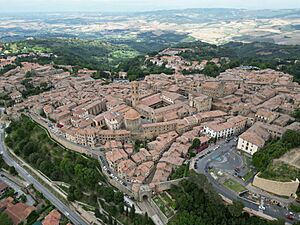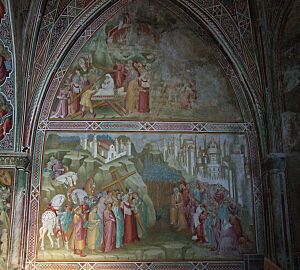Volterra facts for kids
Quick facts for kids
Volterra
|
|
|---|---|
| Città di Volterra | |
 |
|
| Country | Italy |
| Region | Tuscany |
| Province | Pisa (PI) |
| Frazioni | Mazzolla, Montemiccioli, Saline di Volterra, Villamagna |
| Area | |
| • Total | 252 km2 (97 sq mi) |
| Elevation | 531 m (1,742 ft) |
| Population
(1 January 2016)
|
|
| • Total | 10,519 |
| • Density | 41.74/km2 (108.11/sq mi) |
| Demonym(s) | Volterrani |
| Time zone | UTC+1 (CET) |
| • Summer (DST) | UTC+2 (CEST) |
| Postal code |
56048
|
| Dialing code | 0588 |
| Patron saint | St. Justus and Clement |
| Saint day | June 5 |
Volterra is an ancient, walled town located on a mountaintop in the Tuscany region of Italy. Its history goes back more than 2,800 years! You can still see amazing buildings and structures from the Etruscan, Roman, and Medieval times. It's like a living museum!
Contents
Discovering Volterra's Past
Volterra was first known as Velathri by the ancient Etruscans. The Romans later called it Volaterrae. This town is located in the Tuscany region of Italy. It was an important center for the Etruscan civilization. In fact, it was one of the "twelve cities" of the Etruscan League.
People have lived in Volterra as a city since at least the late 8th century BC. This means it's been a city for a very long time! It became a partner city with Rome around the end of the 3rd century BC. By the 5th century, it was a bishop's residence, which means an important religious leader lived there. This power grew even more during the 12th century.
How Volterra Changed Hands
Volterra was once ruled by bishops. But when their power decreased, and valuable alum deposits were found nearby, the Republic of Florence became very interested in the town. Florence eventually took control of Volterra.
However, not everyone in Volterra was happy with Florentine rule. People sometimes rebelled against it. But Florence always managed to put these rebellions down.
In 1530, the Republic of Florence fell. Volterra then came under the control of the powerful Medici family. After that, its history followed the Grand Duchy of Tuscany. In 1472, there was a war between Volterra and Florence, known as the Allumiere War. This war ended with the Duke of Montefeltro and his army taking over Volterra. Many wealthy families had to leave, and their belongings were taken.
What is Volterra's Weather Like?
| Climate data for Volterra (1965–1990) | |||||||||||||
|---|---|---|---|---|---|---|---|---|---|---|---|---|---|
| Month | Jan | Feb | Mar | Apr | May | Jun | Jul | Aug | Sep | Oct | Nov | Dec | Year |
| Mean daily maximum °C (°F) | 7.3 (45.1) |
7.8 (46.0) |
10.3 (50.5) |
13.3 (55.9) |
17.9 (64.2) |
21.8 (71.2) |
25.5 (77.9) |
25.2 (77.4) |
21.5 (70.7) |
17.0 (62.6) |
11.3 (52.3) |
7.9 (46.2) |
15.6 (60.1) |
| Mean daily minimum °C (°F) | 3.2 (37.8) |
3.1 (37.6) |
4.7 (40.5) |
7.1 (44.8) |
11.3 (52.3) |
14.8 (58.6) |
18.0 (64.4) |
18.0 (64.4) |
15.1 (59.2) |
11.6 (52.9) |
6.9 (44.4) |
4.1 (39.4) |
9.8 (49.6) |
| Average precipitation mm (inches) | 64.7 (2.55) |
68.6 (2.70) |
72.0 (2.83) |
70.5 (2.78) |
61.9 (2.44) |
56.6 (2.23) |
46.2 (1.82) |
59.8 (2.35) |
79.3 (3.12) |
88.2 (3.47) |
95.8 (3.77) |
68.7 (2.70) |
832.3 (32.77) |
| Average precipitation days (≥ 1.0 mm) | 8.2 | 8.0 | 8.3 | 9.2 | 7.3 | 6.1 | 3.7 | 5.8 | 7.0 | 7.2 | 8.5 | 8.2 | 87.5 |
| Average relative humidity (%) | 78 | 77 | 74 | 75 | 75 | 73 | 69 | 72 | 75 | 80 | 81 | 80 | 76 |
| Source: NOAA | |||||||||||||
Volterra has a mild climate. Summers are warm, and winters are cool but not freezing. It gets a good amount of rain throughout the year, especially in autumn. This makes the surrounding countryside green and beautiful!
What Fun Events Happen in Volterra?
Volterra hosts several exciting events each year that celebrate its culture and history:
- Volterra Gusto: This event focuses on local food and flavors. It's a great chance to taste traditional Tuscan dishes.
- Volterra Arte: This celebrates art in its many forms. You can see exhibitions and artistic performances.
- Volterra Teatro: This event is all about theater. You can watch plays and performances in historic settings.
Exploring Volterra's Main Sights
Volterra is full of amazing places to visit. Many of them show off its long history.
Ancient Roman and Etruscan Sites
- Roman Theatre of Volterra: Built in the 1st century BC, this ancient theater was discovered in the 1950s. Imagine watching plays here thousands of years ago!
- Roman Amphitheater: This huge arena was found in 2015. It's still being dug up, but it's exciting to see more of Rome's past.
- Etruscan Acropolis and Roman Cistern: The acropolis is an ancient high city area from the 8th century BC. The cistern, a place to store water, is from the 1st century BC.
- The Etruscan Walls of Volterra: These ancient walls protected the city. You can still see well-preserved gates like the Porta all'Arco (from the 3rd-2nd centuries BC) and Porta Diana.
- Etruscan Tombs: In the Valle Bona area, you can find excavations of ancient Etruscan tombs.
Medieval Buildings and Museums
- Piazza dei Priori: This is the main square of Volterra. It's a beautiful example of a medieval Tuscan town square.
- Palazzo dei Priori: This is the town hall, located in the main square. It was started in 1208 and finished in 1257.
- Pinacoteca e Museo Civico: This art museum is in the Palazzo Minucci-Solaini. It opened in 1905 and has many works by Tuscan artists from the 14th to 17th centuries. One famous painting is the Deposition by Rosso Fiorentino.
- Volterra Cathedral: This large church was made bigger in the 13th century after an earthquake. It has beautiful sculptures and paintings by famous artists like Mino da Fiesole and Benozzo Gozzoli. The bell tower was built in 1493.
- Volterra Baptistery of San Giovanni: This round building was built in the mid-13th century. It's where baptisms took place.
- Fortezza Medicea (Medicean Fortress): Built in the 1470s, this fortress is now a prison. It even has a famous restaurant inside called Fortezza Medicea restaurant.
- Guarnacci Etruscan Museum: This museum has thousands of ancient funeral urns from the Etruscan period. Two of its most famous items are the bronze statue "Ombra della sera" (meaning "Shadow of the Evening") and the "Urn of the Spouses," which shows an Etruscan couple.
Other Interesting Places
- Sant'Alessandro: A Romanesque Catholic church.
- Volterra Psychiatric Hospital: This hospital was founded in 1888 and closed in 1978. It has been reopened for public visits and will be used for psychiatric purposes again.
- Palazzo Inghirami, Volterra: Another historic palace in Volterra.
Getting Around Volterra
Volterra has a train station called "Volterra Saline – Pomarance." It's located in the area of Saline di Volterra, which is a short distance from the main town.
Famous People from Volterra
Many notable people have connections to Volterra:
- Persius (34–62 AD): A Roman writer known for his satires.
- Pope Linus: According to historical records, he was born in Volterra and was the successor to Saint Peter.
- Daniele da Volterra (1509–1566): A famous Mannerist painter.
- Giuseppe Bessi (1857–1922): A well-known sculptor.
- Emilio Fiaschi (1858–1941): Another talented sculptor.
Volterra's Sister Cities
Volterra has "twin cities" or "sister cities" around the world. These are cities that have special friendly relationships with each other. Volterra is twinned with:
 Mende, France
Mende, France Wunsiedel, Germany
Wunsiedel, Germany Sandomierz, Poland
Sandomierz, Poland
Images for kids
-
Menelaus and Meriones lifting Patroclus' corpse on a cart while Odysseus looks on; alabaster urn, Etruscan artwork from Volterra, 2nd century BC
See also
 In Spanish: Volterra para niños
In Spanish: Volterra para niños






